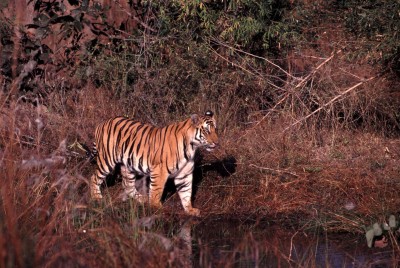NSU Newsroom
SharkBytes
Horizons
This version of NSU News has been archived as of February 28, 2019. To search through archived articles, visit nova.edu/search. To access the new version of NSU News, visit news.nova.edu.
This version of SharkBytes has been archived as of February 28, 2019. To search through archived articles, visit nova.edu/search. To access the new version of SharkBytes, visit sharkbytes.nova.edu.
Nova Southeastern University Researcher Part of Team Researching DNA of Tigers
Results of 10-Year Study Provides New DNA Tools That Can Help Conservation Efforts

The tiger Panthera tigris consists of nine subspecies, including four that have gone extinct from their natural range. The Sumatran tiger is the closest relative to the extinct Javan and Bali tigers.
FORT LAUDERDALE-DAVIE, Fla. – Tigers – they are some of nature’s most beautiful, deadly and endangered species. In fact, living tigers are severely endangered in fragmented geographic areas across Asia – some reports show their numbers as low as 3,000 wild individuals. While there are efforts to help protect these magnificent creatures, more was needed in terms of research into the genetics of tigers.
Nova Southeastern University researcher Stephen O’Brien, Ph.D. was part of a team of research scientists from China, the United Kingdom, Israel, Russia and Qatar that looked at the genetic make-up of tigers. Their 10-year study, which is published online in the Journal of Heredity and will appear in the print edition May 1, 2015, describes DNA signatures for 145 individual tigers, including “voucher specimens” of tigers from verified geographic origins including Eurasian museum specimens that represented extinct subspecies.
Their study’s first results appeared in 2004 that showed Malayan tigers splitting from its Indochinese counterpart as a distinct, new fifth-living tiger subspecies. The latest results show that extinct Javan (1980s) and Bali (1940s) tigers were nearly indistinguishable from a molecular standpoint from Sumatran tigers just as the extinct Caspian tigers are nearly identical to surviving Amur tiger subspecies.
“These results are important to help craft management strategies for protecting each surviving subspecies of tiger and stabilizing the march toward extinction that they are clearly on,” O’Brien said. “These markers also provide powerful tools for forensic identification of subspecies in captive populations as well as trafficked bones and skins in illegal trade enforcement.”
O’Brien likened the new tiger DNA findings to how DNA testing changed the way human courts gather evidence to prosecute cases. The same approach can be applied to tigers as a new, more powerful tool for wildlife protection and, hopefully, reducing illegal wildlife commerce.
Prior to his role with NSU, O’Brien served as Chief of the Laboratory of Genomic Diversity at the National Cancer Institute (NCI,) National Institutes of Health (NIH.) for 25 years. In 2011, he joined the Theodosius Dobzhansky Center for Genome Bioinformatics, St. Petersburg State University (Russia) as its Chief Scientific Officer. He also serves as Director of Research for NSU’s Office of Research and Technology Transfer.
O’Brien is well known for his research contributions in comparative genomics, virology, genetic epidemiology, mammalian systematics and species conservation. In 1983, he and his collaborators discovered the remarkable genetic uniformity of the African cheetah, a prelude to a new discipline of Conservation Genetics. In addition, the past four years, O’Brien has been part of an international consortium of scientists working to detail the genome sequence of 48 different birds. This group of researchers – who call themselves the Avian Phylogenomics Group – is made up of 200 scientists from 80 institutions in 20 countries. This group is an “outgrowth” of the Genome 10K Project (G10K,) which was co-founded in 2009 and led by O’Brien.
With more than three decades of field studies with his students and colleagues, O’Brien subsequently reported in approximately 300 publications, many in the highest rated scientific journals of how genetics could inform and facilitate management action for endangered species. These included identifying new species of elephant, clouded leopard and orangutan plus detailed genetics studies on threatened wildlife species including cheetahs, lions, giant panda, leopards, pumas, jaguars, koalas, humpback whales, the Florida panther and, of course, tigers.
###
About Nova Southeastern University (NSU): Located in beautiful Fort Lauderdale, Florida, NSU is a dynamic research institution dedicated to providing high-quality educational programs at the undergraduate, graduate and first-professional degrees levels. An independent, not-for-profit institution with approximately 25,000 students, NSU has campuses in Fort Lauderdale, Fort Myers, Jacksonville, Miami, Miramar, Orlando, Palm Beach and Tampa, Florida as well as San Juan, Puerto Rico and online globally. For more than 50 years, NSU has been awarding degrees in a wide range of fields, while fostering groundbreaking research and an impactful commitment to community. Classified as a research university with “high research activity” by the Carnegie Foundation for the Advancement of Teaching, NSU is one of only 37 universities nationwide to also be awarded Carnegie’s Community Engagement Classification. For more information, please visit www.nova.edu
Media Contact
Joe Donzelli | Office of Public Affairs
954-262-2159 (office)
954-661-4571 (cell)
jdonzelli@nova.edu